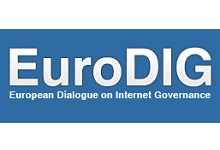Regulation and the Internet economy: How to create the right building blocks for 5G networks
19 Jun 2019 14:00h - 15:30h
Event report
[Read more session reports and live updates from the EuroDig 2019]
Ms Kristina Olausson (Public Policy Manager, European Telecommunications Network Operators’ Association (ETNO)) moderated the session and launched the discussion by considering the difficulty in balancing innovation and regulation, taking the 5G technology as an example: Although 5G is a promising technology, challenges regarding its implementation and regulation persist.
Mr Thomas Grob (Senior Expert Regulatory Strategy, Deutsche Telekom) stated that although 5G technology promises a great potential for the Internet users (e.g. in terms of massive broadband and faster communication), its primary applications will target the private sector. He took industrial campus networks as an example: exclusively mobile networks for defined local campuses connecting multiple production sites wirelessly. Compared to the current 4G technology, 5G promises greater advantages for a business that wants to strengthen its campus network(s), namely a very high bandwidth, short latencies, and improved availability. He considered that the existing challenge of this model is the co-existence of two networks: the public network and the private one, which is logically and physically separated from the first one. From a regulatory perspective, the question is a net neutrality and a zero-rating one: to what extent such service will interfere with the existing public service that is already being provided by telecom companies? He noted that this application is currently being tested in Germany to see whether the performance of the public network is affected by the co-existence of the private one.
Grob concluded by proposing three hypothetical regulatory scenarios and solutions. Firstly, in a situation where consumers and verticals will benefit from innovative services and increased choices, no pre-emptive regulatory protection would be needed. Secondly, if networks delivered the requested differentiation of services and, therefore, increase competition, then regulations will need to re-orientate and favour infrastructure investment. Thirdly, a need for a smart traffic management system would not conflict with existing net neutrality rules.
Mr Jan van Alphen (ICT Strategy Advisor to the CIO, INTUG & BTG – International Telecom Users Group) brought the business users and consumers’ perspective to the discussion and outlined three main challenges connected to the implementation of 5G technology. Regarding the infrastructure and capacity, such technology will demand high density, the possibility for remote management, avoiding any congestion for a multi-user environment, and an increased capacity to allow for real-time communication. All these elements are difficult to implement and will require work towards the creation of an end-to-end environment, the availability of full bandwidth coverage, as well as ensure continuity of business processes. On the auction and spectrum allocations side, he stated that auctions should not burden the market development and innovation and that national and international regulatory discussions should not hinder the development of 5G technology. Moreover, any regulatory approach should also encompass the fact that affordable prices, cost transparency rules, and full competition among operators are necessary elements to be considered. Lastly, regarding national and international regulatory approaches, he stressed the urgency to address 5G technology-related challenges especially in terms of net neutrality and zero-rating concerns.
Ms Hanane Boujemi (Executive Director, Tech Policy Tank) approached the discussion from a policy perspective: she stated that the integration and dialogue among the two different worlds at stake in the discussion (i.e. the telecom world and the policy one) have still to happen. She considered that it is important to keep specific benchmarks in checks to better understand the societal impacts of an emerging technology. As the consequences of the introduction of a new technology are often difficult to foresee, she pushed for a more inclusive discussion not only in terms of the parties at the table (i.e. towards a multistakeholder approach representing the telecom and tech companies, regulators, and manufacturers) but also vis-à-vis the subject under discussion: ‘do we want a more human-centred approach in a technological world?’, she asked. She considered that besides the positive implications of 5G technology, discussions should also encompass technology’s limitations (e.g. security and data protection concerns) as well as consider the magnifying effect that one technology could have on the development of others, namely 5G’s impact on artificial intelligence (AI).
Mr Ola Bergström (Director for International Affairs, Swedish Post and Telecom Authority (PTS)) also considered that, compared to previous telecom regulations, 5G regulatory approaches are more complex because they are not simply a matter of competition law, but rather of (cyber)security, data and consumer protection – all of which should be carefully balanced. Moreover, compared to previous regulatory approaches, with 5G technology new actors should also be included, namely the broader private sector, in addition to telecom operators and vendors which have been traditionally consulted by regulators in the policy drafting phase.
The moderator closed the session highlighting an emerging call for more agile regulatory frameworks, especially towards new technological developments such as 5G. Such frameworks require the integration of experts from different sectors, as well as the need to break the silos and create better frameworks for multistakeholder co-operation.
By Marco Lotti
Related topics
Related event

